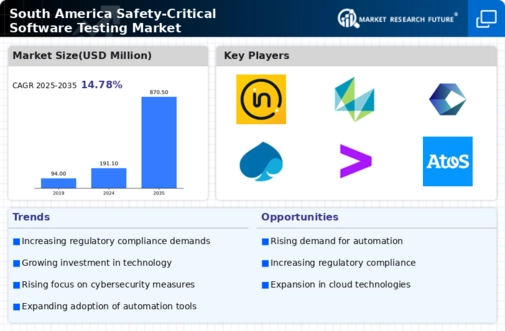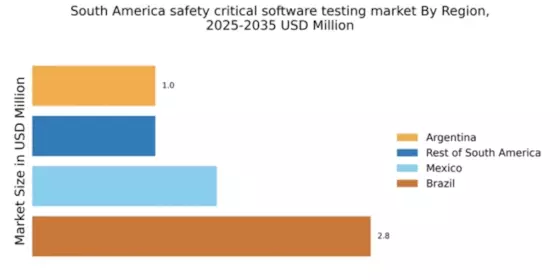Rising Cybersecurity Concerns
As digital transformation accelerates, cybersecurity has emerged as a critical concern for organizations in South America. The increasing reliance on software systems in safety-critical environments has made them attractive targets for cyberattacks. The safety critical-software-testing market is responding to these challenges by integrating cybersecurity testing into their protocols. This integration ensures that software systems are not only functionally sound but also secure against potential threats. Recent studies indicate that nearly 70% of organizations in South America are prioritizing cybersecurity in their software development processes. This rising concern for cybersecurity is driving demand for comprehensive testing solutions, thereby propelling growth in the safety critical-software-testing market.
Government Initiatives and Funding
Government initiatives aimed at enhancing safety standards across various sectors are playing a pivotal role in the growth of the safety critical-software-testing market in South America. Several countries are implementing regulations that mandate rigorous testing of software used in critical applications, such as healthcare and transportation. These regulations often come with funding opportunities for organizations to develop and implement safety testing protocols. For instance, a recent initiative in Brazil allocated approximately $200 million to support the development of safety-critical software systems. Such government backing not only fosters innovation but also encourages compliance with safety standards, thereby driving the demand for safety critical-software-testing services.
Increasing Demand for Safety in Transportation
The transportation sector in South America is experiencing a heightened focus on safety, particularly in the context of software systems used in vehicles. As urbanization accelerates, the need for reliable and safe transportation solutions becomes paramount. The safety critical-software-testing market is responding to this demand by developing rigorous testing protocols to ensure that software systems in vehicles meet safety standards. According to recent data, the automotive sector is projected to invest approximately $1.5 billion in safety-related software testing by 2026. This investment reflects a growing recognition of the importance of software reliability in preventing accidents and ensuring passenger safety. Consequently, the increasing demand for safety in transportation is a significant driver for the safety critical-software-testing market in South America.
Growing Awareness of Software Quality Assurance
There is a growing awareness among organizations in South America regarding the importance of software quality assurance, particularly in safety-critical applications. As industries recognize the potential risks associated with software failures, there is an increasing emphasis on implementing robust testing frameworks. The safety critical-software-testing market is benefiting from this trend, as companies seek to enhance their software reliability and minimize risks. Surveys indicate that over 60% of organizations are now prioritizing quality assurance in their software development lifecycle. This shift in mindset is likely to lead to increased investments in safety testing solutions, further propelling the growth of the safety critical-software-testing market in South America.
Technological Advancements in Software Development
Technological advancements are reshaping the landscape of software development across various sectors in South America. The emergence of new programming languages, frameworks, and tools is enhancing the capabilities of software systems, particularly in safety-critical applications. The safety critical-software-testing market is adapting to these changes by incorporating advanced testing methodologies that leverage artificial intelligence and machine learning. These technologies enable more efficient testing processes, reducing time-to-market while ensuring compliance with safety standards. As organizations increasingly adopt these innovations, the market for safety critical-software-testing is expected to grow significantly, with estimates suggesting a compound annual growth rate (CAGR) of around 12% over the next five years. This trend indicates a robust future for the safety critical-software-testing market in South America.


















Leave a Comment